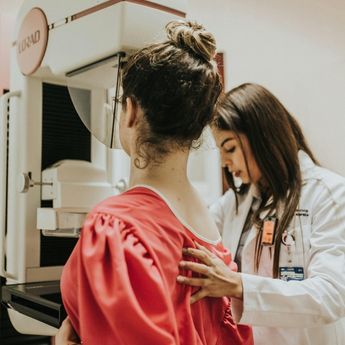When going through breast cancer, you often hear about different kinds of tests like scans, biopsies, and blood work. One new kind of test that’s starting to gain attention uses ctDNA or circulating tumour DNA. You may also hear it called a liquid biopsy. But what is it? And how could it help in breast cancer care?
What can ctDNA be used for?
Circulating tumour DNA is cancer-related DNA that can be found in the blood. Normally, there is DNA located inside the centre of a cell, called the nucleus. But when a tumour grows, some of its cells die and break apart. As they break down, bits of their DNA are released into the bloodstream. These small pieces of DNA are called ctDNA.
ctDNA is used to conduct a liquid biopsy, a simple and non-invasive test that use a blood sample to look for cancer cells or their genetic material. Unlike regular biopsies, it doesn’t require surgery to take a piece of the tumour.
ctDNA can be used in many ways:
- Diagnosing recurrence: After breast cancer surgery, doctors can test your blood for ctDNA to see if any cancer cells are still in your body. This is called minimal residual disease, or MRD. During follow-up care, finding ctDNA in your blood might be a sign that the cancer has come back.
- Checking how treatment is working: For people with stage IV or metastatic breast cancer, measuring ctDNA before and during treatment can help show how well treatments like chemotherapy or immunotherapy are working.
- Predicting how the disease will progress: ctDNA in the blood can be used as a biomarker (a sign in your body that helps doctors understand or track a disease) to help predict the chances of the cancer returning and what your outlook might be—especially in early-stage hormone receptor, HER2-negative breast cancer (HR+, HER2-) and triple-negative breast cancer (TNBC).
- Finding changes in the tumour: ctDNA can show genetic changes in the tumour, like mutations that suggest the cancer is becoming resistant to certain treatments, something that might not appear on imaging tests.
What are the current challenges?
There are some challenges with using liquid biopsies. One problem is that ctDNA doesn’t stay in the blood very long— only up to about 2 hours. This makes it hard to track changes in the tumour or choose the most accurate treatment. Because of the short half-life of ctDNA, as well as the very small amounts that circulate, testing could reveal a false negative or false positive.
Also, since ctDNA is a new and fast-developing tool, there are still no clear rules or standards for how tests should be done across different hospitals and labs. These issues can sometimes result in having to do a regular biopsy as a follow-up to rule out any inconsistencies.
How is ctDNA currently used in breast cancer care?
Although ctDNA tests appear to show significant promise in predicting cancer recurrence and monitoring treatment progress, their widespread clinical use is still limited. Right now, ctDNA may only be available through research studies or private testing.
Like any emerging technology in the medical field, more research is needed to validate the use of these liquid biopsies and develop consistent standards before they can be used in routine practice. As scientists continue to refine this tool and improve its accuracy and reliability, it is likely that they will play an increasingly important role in personalized care.







